In the late 1970s and ‘80s, Volodymyr Shevchenko designed one of the most original buildings in Kyiv: a former medical clinic that city history buffs call a Soviet architectural monument.
Today, however, Shevchenko, 67, rarely comes to see the project of his youth. It has fallen into disrepair and is threatened with shoddy renovations.
“After it started to be exploited by anyone and everyone, coming here is simply pointless. And to watch it die while nobody cares is just hard,” Shevchenko told the Kyiv Post.
Around the world, Soviet architecture is experiencing an aesthetic boom. Kyiv’s Soviet buildings have become prime settings for Western music videos, ads and films like the hit “Chernobyl” miniseries. They have been featured in photo books on architecture and design in the West.
But Ukraine is hardly as excited about these buildings. As the country moves forward from its communist past, the architecture of the era bears a double burden: ordinary decay and stigma against anything Soviet.
Still, a few people do care about protecting this cultural heritage. The Save Kyiv Modernism initiative has united architects, historians and architecture lovers to fight for the protection and renovation of Soviet-era buildings in Ukraine, starting with Kyiv.
Most of its members weren’t yet born or were just children in the final years of the Soviet Union, so they don’t associate this architecture with political repressions or bread lines. For them, it’s just form and function.
“And this form is expressive, of course, it has curves and everything!” architect and activist Alex Bykov, 33, told the Kyiv Post. “It’s like shouting ‘Look at me!’”
Devil-may-care
Unlike in the Soviet Union, today many of these buildings are private property. They belong to owners who often took possession of them through corrupt privatization schemes. Many owners care little for their cultural or historical value.
Even when the state is the owner, bureaucracy often stands in the way of preservation efforts.
To raise awareness, Save Kyiv Modernism appeals to the owners and authorities, publishes articles, organizes photo exhibitions and designs renovation plans. This creates public pressure that has helped preserve some buildings.
Without the activists’ efforts, hardly anyone would protect these structures. Few of them have official status as architectural monuments that would ensure institutional protection.
Moreover, since 2014, Ukraine has removed thousands of Soviet symbols and monuments as part of a “de-communization” process across the country. Often gray and monolithic, Soviet buildings hardly call to mind the European future to which the country aspires.
But Save Kyiv Modernism is convinced they have cultural value.
In June, Bykov and architecture scholar Ievgeniia Gubkina published a book called “Soviet Modernism. Brutalism. Post-Modernism” to draw more attention to these buildings. The book captures and critically evaluates Soviet architecture in Ukraine, arguing that it should be protected just like buildings from the 18th and 19th centuries.
“Like the 19th-century romantic fascination with the ruins of ancient Greek temples, Egyptian pyramids, and medieval castles, the ‘cyclopean’ (massive and rough) structures of Soviet Modern architecture call up feelings of nostalgia, loss, and a desire to study and protect them,” Gubkina writes.

An example of Soviet postmodernist architecture, the former medical clinic of the Writers Union on Reitarska Street in Kyiv is slowly growing dilapidated. It is threatened by shoddy renovations. (Volodymyr Petrov)
Postmodernist clinic
The medical clinic designed by Shevchenko is featured in the book as an example of Soviet postmodernism. Peculiar, stylish but a little worn out, it stands at 15 Reitarska St. in central Kyiv.
It was a tough project. Commissioned in 1976 for the Writers Union of Soviet Ukraine, the clinic had to house offices for nearly every kind of specialist while standing on a small and shaded patch of land. The union wanted a physical therapy unit, too.
An architect in his 20s, Shevchenko designed the building to rise like a series of steps from the third to the sixth floor. The top of each floor was a summer terrace. An adjacent round building housed the physical therapy unit.
The stair-like structure ensured that the neighboring apartments would get at least 2.5 hours of sun exposure a day, as required by Soviet building regulations. And the bare facade of local, hand-picked bricks helped the clinic blend in with surrounding historic buildings.
The limitations of Soviet regulations and available materials combined with characteristics typical to Western postmodernism – allusions, imitations, regionalism – created a special hybrid style of Soviet postmodernism.
Today the clinic is mostly deserted. It houses a few general-purpose offices recognizable by their white plastic window frames. The company that owns the building is Brakerazh LLC, which made the purchase last year.
Ukrainian media have reported that the leadership of the Writers Union illegally transferred the building from communal to private property in 2007. Despite that, returning it to the Writers Union or the state would be difficult legally, since the building has changed hands several times since then.
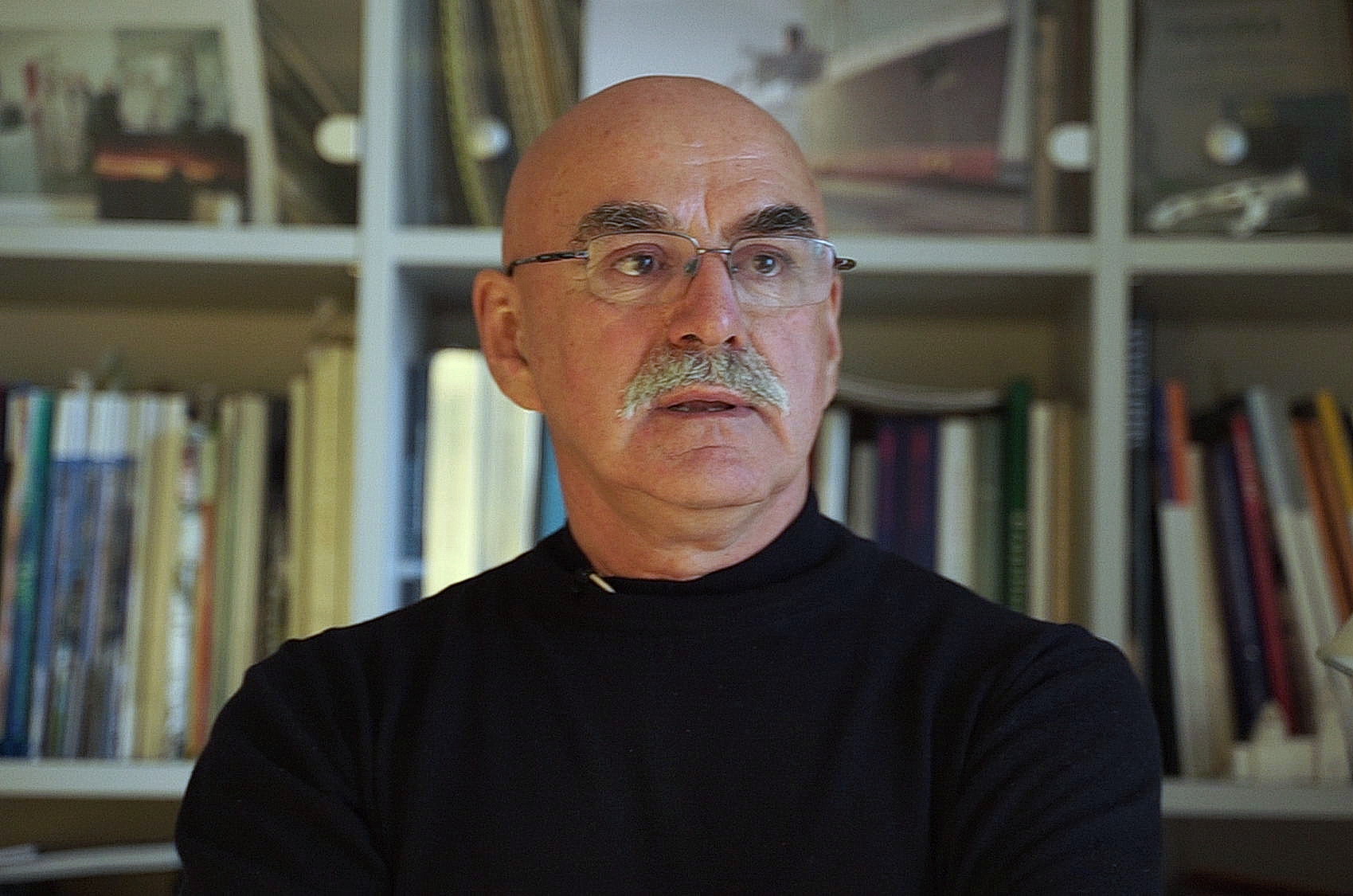
Volodymyr Shevchenko, an architect of the Soviet generation who designed the former medical clinic of the Writers Union on Reitarska Street, speaks to the Kyiv Post on Nov. 4, 2019 in Kyiv. (Ruslan Batytskyi)
Shevchenko is trying to persuade the owners that parts of the building need immediate repair: Some bricks are crumbling near the top floors due to worn-out insulation. Instead, the owners started to remodel the interior. Shevchenko says this must not affect the facade.
“The facade should be renovated with the involvement of the project’s authors. The new people could do something different, and the building will lose its value,” Shevchenko says.
A case in point is the physical therapy unit, which has been turned into a spa-center by other private owners. They remodeled it to look like a round white fairytale castle with turrets. Shevchenko calls it “a stump with mushrooms sticking out.”
He says that the owners and authorities should follow the law on intellectual property rights when renovating or remodeling such buildings. The law allows the creator to approve or deny “alterations” to his or her architectural works.
“It’s mindless and uncivilized how the new owners redo the buildings in spite of the author’s rights and the law, which simply gets ignored with regard to architecture,” Shevchenko says.
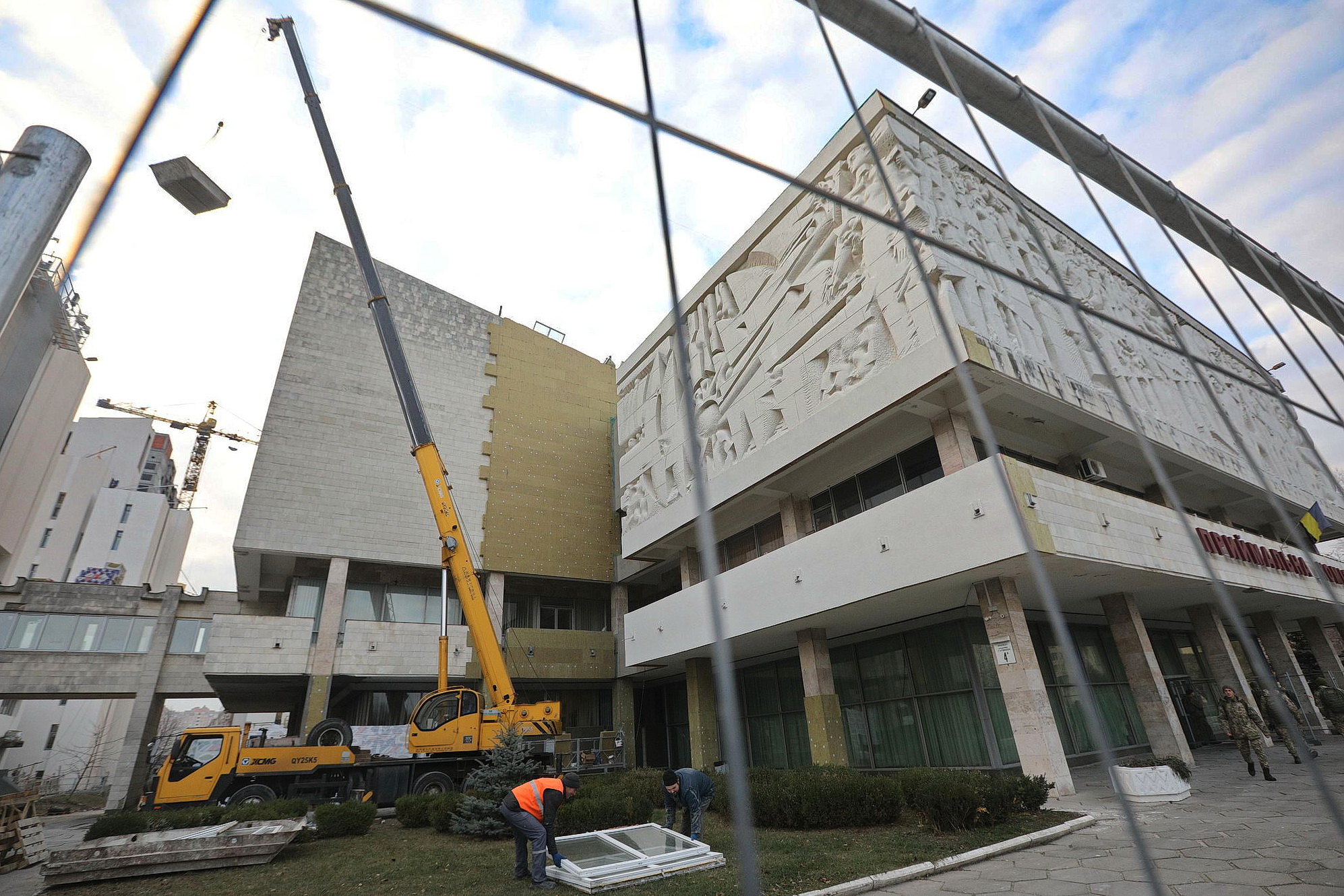
Soviet brutalist buildings housing two departments of the Taras Shevchenko National University are being thermally insulated, which will affect their appearance and may cause them to lose artistic value. (Kostyantyn Chernichkin)
Brutalist university buildings
But what if the building’s original creators are inaccessible or deceased?
Mykhailo Budilovsky, the main architect of the Taras Shevchenko National University campus at 4 Akademika Hlushkova Ave., lives in Chicago, while most of the project’s co-authors have died. So it fell upon the activists to protect some of his buildings from an unexpected threat.
The two buildings in question were designed in the 1970s and now hold university departments of exact sciences. Reflecting the precision of the disciplines, the structures have strict geometrical shapes and bare limestone walls. Bykov and Gubkina characterize it as Soviet brutalism.
Bas-relief carvings of idealized men and women pursuing knowledge and socialist labor highlight the entrances to the buildings. Over time, they have dimmed from white to dark grey.
Soviet brutalism functioned as an official style that reflected the state’s policies and carried propagandistic messages. But there were a few groups of architects that still created original pieces that Gubkina calls “unofficial brutalism.” Budilovsky was one of their leaders.
“Besides the cultural repression that existed at the time, we may find alternative and original currents in this period’s architecture. For a small number of artists who stood their ground, the traumatic experience gave them the opportunity to create outstanding pieces,” Gubkina writes.
Two such pieces by Budilovsky house departments of mechanics and math, sociology, computer science and cybernetics. But they came under threat when the departments’ deans started to thermally insulate the buildings this spring. The term the university uses is “thermal modernization.”
The grey limestone walls were to be plastered and painted with bright colors, the aluminum windows were to be replaced with white plastic ones and it was unclear whether the bas-reliefs would be covered up for insulation.
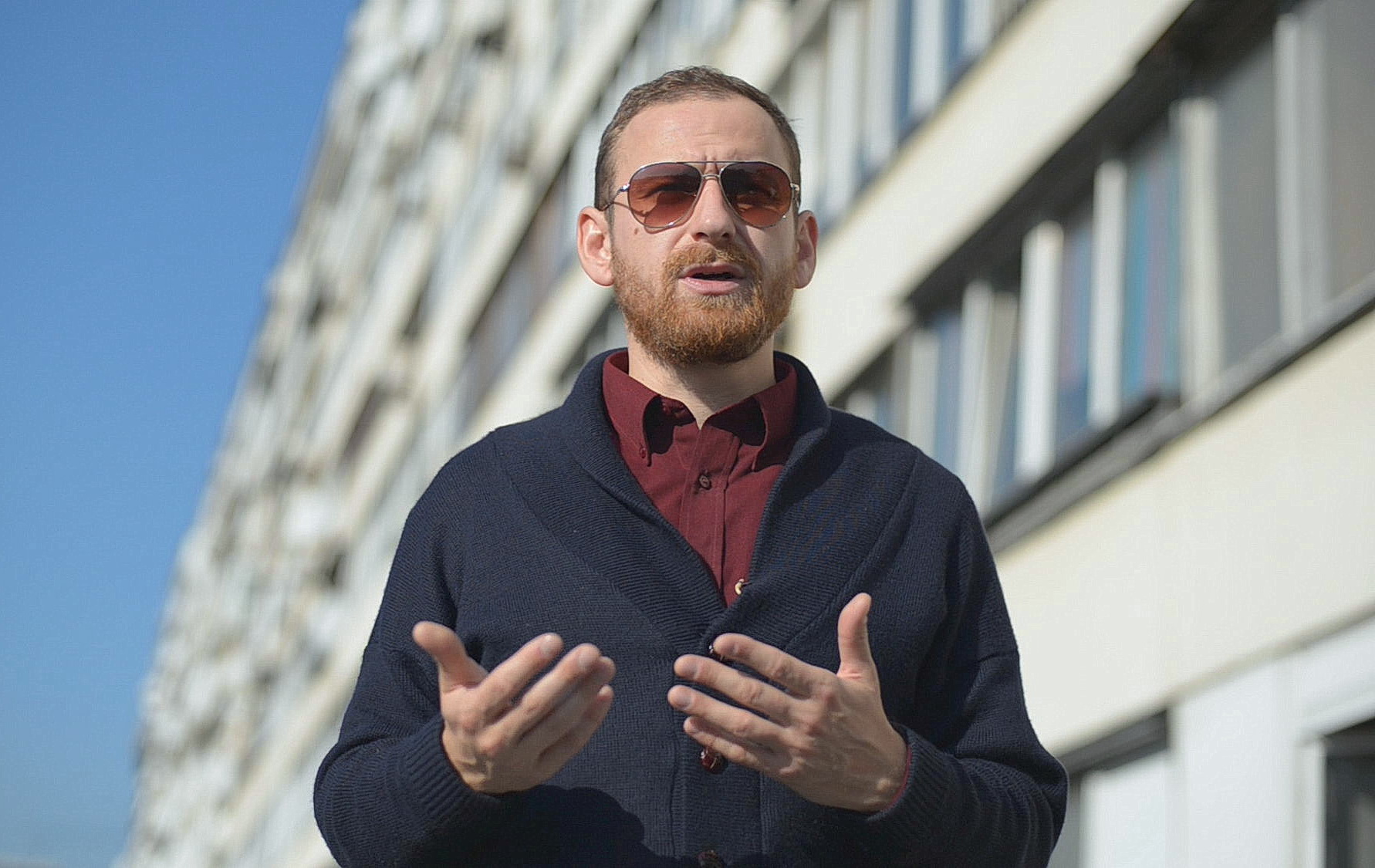
Alex Bykov, architect and co-founder of the Save Kyiv Modernism initiative, speaks to the Kyiv Post on Oct. 18, 2019 in Kyiv. (Ruslan Batytskyi)
Bykov and Shevchenko demanded that the university show the blueprints for the insulation works. Both say that the plans were unprofessional. So the activists pressured the university to assign an engineer to coordinate the project who now oversees the works instead of the deans.
“It became increasingly clear that it was all a makeshift job,” Bykov told the Kyiv Post.
The activists suggested putting insulation under the limestone, which would require removing the stone and then putting it back. The bas-reliefs’ co-author Volodymyr Priadka suggested leaving the artworks as they are since mechanical cleaning could damage the stone.
“This same shelly limestone is preserved blackened on iconic European architecture,” Bykov says. “The beauty is to see how natural materials change over time.”
In the end, the university cleaned the bas-reliefs with brushes under water pressure. Next, it will cover them with what the project’s engineer calls “a special paint for such surfaces.” The rest of the outer walls are being plastered and most windows will be replaced with white plastic ones.
The activists only got to choose a neutral grey paint for the plastered walls.
“We tried to save the facade’s shapes, style and idea to the maximum. I’m completely satisfied,” the project’s engineer, Bohdan Zhyvchyk, told the Kyiv Post.
The university suspended the works for the summer but resumed in September without informing the activists. But Save Kyiv Modernism monitors the process: Bykov took pictures at the site while talking with the Kyiv Post.
“We tried at least to figure out what was happening and put them on the right path. We succeeded in some things,” Shevchenko says. “We don’t know how this could have ended otherwise.”
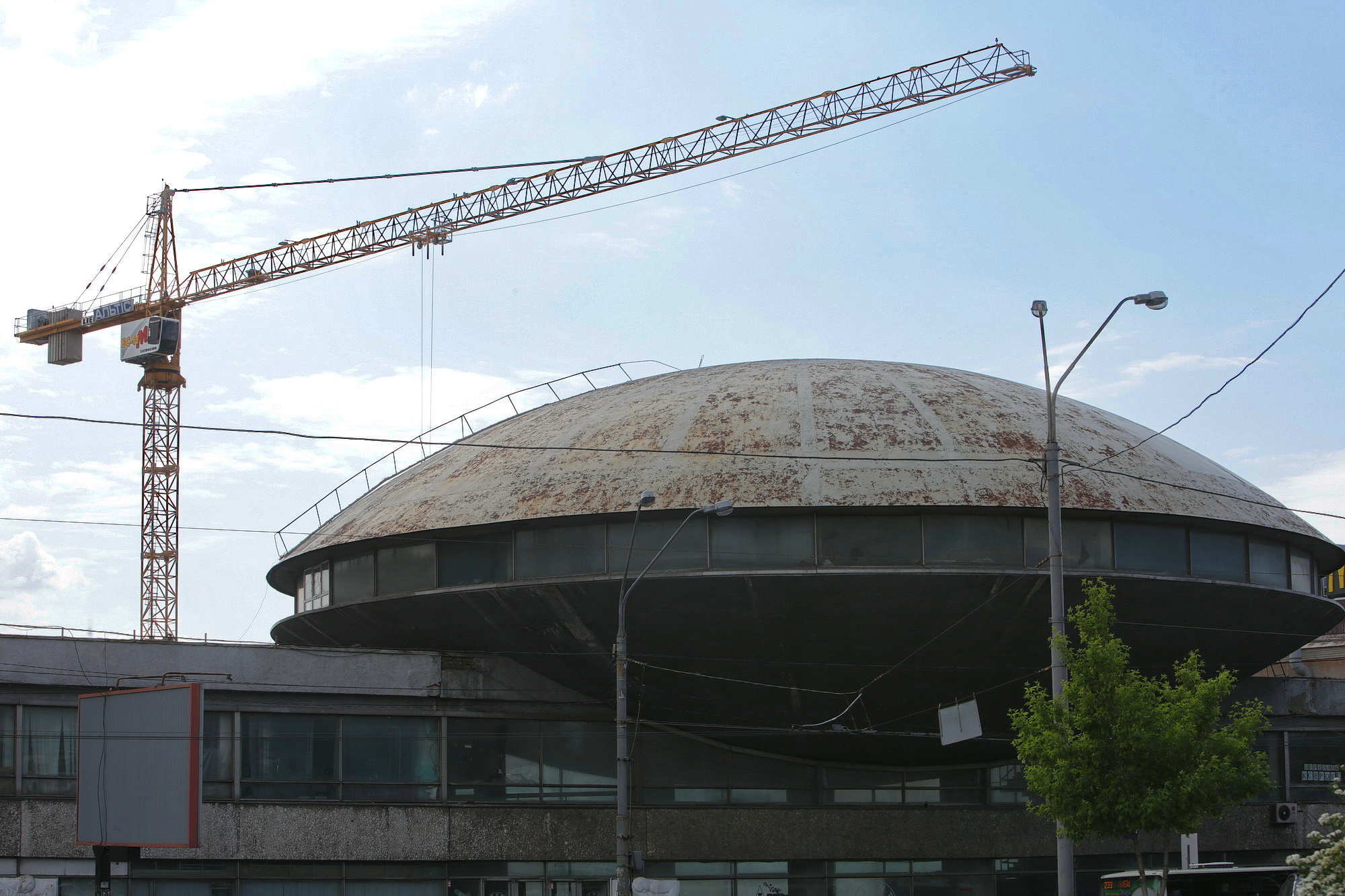
The so-called “Flying Saucer” was designed in the 1960s by then young and promising architect Florian Yuriev to reflect the ideas of the Space Age. The main client was the KGB. (Kostyantyn Chernichkin)
Modernist ‘Flying Saucer’
The showcase of the Save Kyiv Modernism initiative is the so-called “Flying Saucer” or “The UFO,” located at 180 Antonovycha St. Arguably the most recognizable modernist building in Ukraine, the Saucer risks being swallowed by a mall under construction behind it.
Save Kyiv Modernism has done a lot to protect the Saucer: appealing to authorities, launching a social media campaign, publishing articles and organizing exhibitions. Activist Oleksiy Radynski has directed a short documentary on the subject, now being produced as a full-length film.
But nothing has changed since the initiative started in November 2017 with a lecture by the Saucer’s creator, Florian Yuriev, who is now 90. There, Yuriev and the activists first spoke about the danger of the Saucer being reconstructed as the entrance to the new mall looming behind it.
Bykov says this would destroy the building as a Soviet modernist architectural monument.
“What’s being built behind Tarilka destroys its city-planning composition,” Bykov says. “Changing its function from a community center to a mall reception hall is destruction too.”
The Flying Saucer looks just like it sounds – as if it’s floating above the two-story building that houses the State Scientific-Technical Library. Another part of this architectural group is the sixteen-story building to the left that towers over the saucer and defines the space over it.
Commissioned in the 1960s, these buildings were designed to reflect the ideas of cosmic travel after the first human spaceflight in history by a Soviet astronaut. They also had to house the archive of the KGB, the USSR’s main security agency.
The Kyivproekt city planning monopoly assigned the project to Yuriev, then a young and promising architect. The KGB was the main client, so, despite opposition to Yuriev’s daring design in the Architects Union, the project was given the go-ahead.
The KGB’s backing also guaranteed the resources to carry out the construction of the ambitious design. The bottom of the Saucer is made of a reinforced concrete monolith that stands on eight hidden pillars, while the top is a single giant piece of welded metal.
The hall inside the Saucer was used as a venue for lectures, concerts and movie screenings. According to Yuriev’s design, the hall should also have featured a special lighting system, where colors would reflect musical notes according to his “color-music” concept. But that idea was not realized.
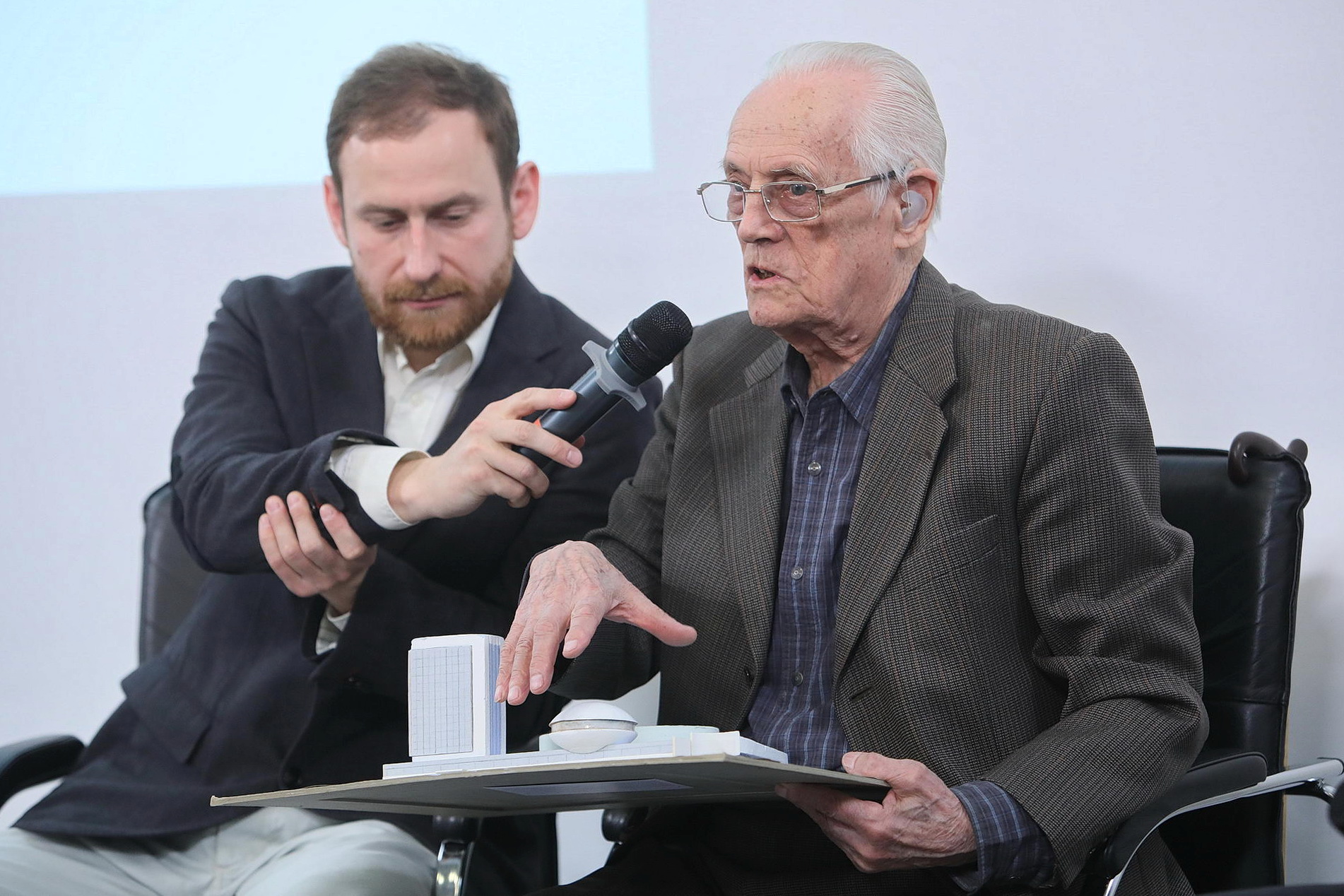
Florian Yuriev (R), the architect of the so-called “Flying Saucer,” speaks at the presentation of the activists’ “renovation and development” project of the building, aided by architect and activist Alex Bykov, in Kyiv on May 13, 2019. (Volodymyr Petrov)
The Saucer now belongs to the Ministry of Education, which rented it out for 20 years to the Mandarin Plaza Group owned by the major developer Vagif Aliyev. According to the contract, the developer is required to renovate the building and create a science museum there.
But while the developer has been building the new Ocean Mall for two years, he has not done much work on the Saucer itself. It’s just a matter of time before he does, activists say. But they are also concerned as the developer has not revealed the construction plans, only showing projected images of the facade.
Oleksandr Chernytskyi, board chairman of the Mandarin Plaza Group, says that they have been cooperating with Yuriev and have shown him the construction plans. Chernytskyi promised to share the plans with the Kyiv Post, but hasn’t done so.
“These people (the activists) have too much free time, so they get agitated,” Chernytskyi told the Kyiv Post. “With all due respect, Florian Yuriev is a very old man. These fellows are manipulating him.”
Yuriev, who comes off as lucid and thoughtful, has repeatedly spoken out in public that he is against the developer’s reconstruction of the Saucer. He instead voiced support for the alternative “renovation and development” project that the activists designed under his guidance.
“We will fight for our concept of the Saucer – a communal object with ideological and artistic value,” Yuriev said at the presentation of the activists’ project in May. “The counter-project aims to turn the object into a trading hall.”
The alternative project for the Saucer brought together architects, designers, engineers and financiers working for free. While trying to preserve the original look and purpose of the building, the project expands its functions to include lecture halls, exhibition spaces, administrative rooms and a cafe.
The activists’ project imagines how the main venue hall can include Yuriev’s color-music system by applying modern technologies. It also has a detailed financial plan for such renovations and the returns the building can bring as a venue. The project was made public online.
Yuriev and the activists say they presented this “renovation and development” project personally to the developer Aliyev on several occasions. Meanwhile, Chernytskyi says he has only heard about the project and calls it “naive.”
Regardless of what happens next, the Save Kyiv Modernism activists have demonstrated how civil society can come together to help protect and renovate Soviet modernist architecture.
“Nobody has yet renovated Soviet modernism in the history of mankind,” Bykov says. “If we succeed with the Saucer, the world will see that we can work with this architecture, with our complicated heritage.”
